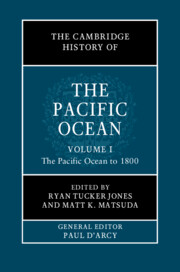Book contents
- The Cambridge History of the Pacific Ocean
- The Cambridge History of the Pacific Ocean
- The Cambridge History of the Pacific Ocean
- Copyright page
- Contents
- Figures
- Tables
- Contributors to Volume I
- Frontispiece
- General Editor’s Introduction
- Preface to Volume I
- Part I Rethinking the Pacific
- Part II Humans and the Natural World in the Pacific Ocean
- Part III Deep Time: Sources for the Ancient History of the Pacific
- 10 Biological Anthropology and Genetics in Pacific History
- 11 The Word as Artefact
- 12 Oral Traditions in Pacific History
- 13 The Evolution of Pacific Island Societies
- 14 Ancient Voyaging Capacity in the Pacific
- 15 Revitalizing ‘Traditional’ Navigation Systems in the Contemporary Pacific
- Part IV The Initial Colonization of the Pacific
- Part V The Evolution of Pacific Communities
- Part VI Europe’s Maritime Expansion into the Pacific
- References to Volume I
- Index
15 - Revitalizing ‘Traditional’ Navigation Systems in the Contemporary Pacific
from Part III - Deep Time: Sources for the Ancient History of the Pacific
Published online by Cambridge University Press: 11 November 2022
- The Cambridge History of the Pacific Ocean
- The Cambridge History of the Pacific Ocean
- The Cambridge History of the Pacific Ocean
- Copyright page
- Contents
- Figures
- Tables
- Contributors to Volume I
- Frontispiece
- General Editor’s Introduction
- Preface to Volume I
- Part I Rethinking the Pacific
- Part II Humans and the Natural World in the Pacific Ocean
- Part III Deep Time: Sources for the Ancient History of the Pacific
- 10 Biological Anthropology and Genetics in Pacific History
- 11 The Word as Artefact
- 12 Oral Traditions in Pacific History
- 13 The Evolution of Pacific Island Societies
- 14 Ancient Voyaging Capacity in the Pacific
- 15 Revitalizing ‘Traditional’ Navigation Systems in the Contemporary Pacific
- Part IV The Initial Colonization of the Pacific
- Part V The Evolution of Pacific Communities
- Part VI Europe’s Maritime Expansion into the Pacific
- References to Volume I
- Index
Summary
In learning traditional seafaring, I, like other master navigators in the Pacific, learned early on that the land at the stern of my canoe, the land from which I departed, is a critical reference point when setting off on any voyage. Before departure, navigators are trained to study and understand the position of our home island, especially identifying the specific stars rising above the land. It is only after knowing from where we came that we can adjust our course correctly. This literal knowledge of the stars and land is also important as a metaphor, teaching us that in order today to move forward, we must look back and know from where we came. We must cherish our Indigenous knowledge of the past in order to guide our journey into the future. It is in this spirit of searching our past that much of the cultural renaissance of today has flourished. This chapter highlights efforts in these islands to promote and preserve such knowledge in the face of imminent challenges including human-induced changes and escalating natural disasters. It is shaped and structured by traditional knowledge which is passed on orally and learned through practice as it has been for countless generations. All knowledge recounted in this chapter was learned this way, and here I have attempted to transfer it to text as closely as possible as a way of demonstrating Pacific ways of learning.
- Type
- Chapter
- Information
- The Cambridge History of the Pacific Ocean , pp. 345 - 366Publisher: Cambridge University PressPrint publication year: 2023



